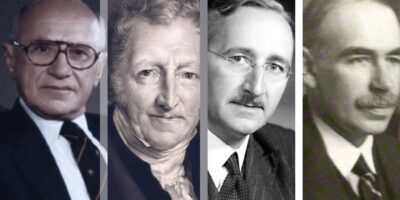Kenneth Arrow and the Odd Form of Dictatorship He Helped Create

Kenneth Arrow was undoubtedly one of the most influential economists of the 20th century. Winner of the 1972 Nobel Prize in economics, the profession’s highest honor, as well as receiver of numerous other accolades, his contributions spanned decades and a vast array of topics. Arrow, it can be stated definitively, is a pillar of mainstream economics.
And yet, Arrow also held some pretty controversial views, which have not received much attention from the broader economics profession. Perhaps his most controversial stance was that he appeared to favor a peculiar form of dictatorship as his preferred means of organizing economic activity. Even more strange, his way of framing policy priorities has had enormous influence on economists.
For decades, economists have debated a simple question: How does one know whether a government policy should be adopted or not? This question framed discussions about “cost-benefit analysis” (CBA), or how to evaluate the inevitable tradeoffs inherent in policymaking.
While CBA as a broad framework enjoys widespread support, there remain fundamental disagreements among economists about it, including about its foundations, i.e., what it measures. Arrow’s position, along with many other mainstream economists, was that CBA should be based on a mathematical formula describing “social welfare,” i.e., a formula that calculates the well-being of all members of a particular community. The exact welfare function he endorsed was derived from a popular economic growth model, known as the Ramsey model.
It should be stated that not all economists endorse this social welfare function approach. Some outright reject the notion that any mathematical function can adequately capture something as complex as social welfare, and ironically, these economists often cite Arrow in defense of their view.
Why? It turns out Arrow was also the author of a devastating critique of social welfare functions. Now known as “Arrow’s impossibility theorem,” the paper essentially proved that no social welfare function can possibly describe the aggregated preferences of all members in a community, unless, that is, certain seemingly reasonable premises are rejected.
These premises, in a nutshell, are that all individuals’ preferences get considered in the social welfare function; that the function can compare any set of alternatives to one another and rank them in a way that is not contradictory; that if all individuals prefer one option to another, then the function prefers that option too; that a preferred option doesn’t change when an irrelevant option is added or removed from the list of choices; and that no one is made a dictator whose preferences the social welfare function mirrors.
What Arrow proved is that no one social welfare function could satisfy all of these criteria at once. The question then is, how could Arrow, who authored the most famous critique of social welfare functions in history, have endorsed a social welfare function himself?
The answer is that the way around his impossibility theorem is to relax one of the restrictive assumptions. For example, implicit in next-to-last assumption about irrelevant alternatives is that an analyst can’t attach numbers to people’s preferences and then add them up. That assumption has been questioned by John Harsanyi, among others. Harsanyi, who happened to be a student of Arrow’s, proved that a social welfare function can be generated by adding up weighted versions of individuals’ welfare functions.
The difficulty, of course, is reaching consensus about what weights to use so that one person‘s welfare can be compared to another’s. In fact, Arrow was quite clear that with more information, his impossibility theorem can be overcome. But Arrow did not endorse Harsanyi’s method. Rather, the social welfare function he preferred was a simple utility function for an individual that did not include any of the kinds of weights required by the Harsanyi method.
How then does Arrow arrive at his welfare function? The first three assumptions are fairly uncontroversial, although some scholars, such as Amartya Sen, have questioned them at times. What seems more likely is that Arrow got around his impossibility theorem by relaxing the final constraint. The social welfare function he endorsed is a single individual’s utility function—someone who looks a lot like a dictator.
Sometimes this welfare function is said to describe a “social planner’s” preferences. Arrow himself described it this way on occasion. Maybe he thought policy should attain to please some higher power, for example. However, at other times, when he was apparently feeling less mystical, Arrow said that he believed an analyst could assume all individuals in a particular generation have identical preferences. For modeling purposes, then, he thought one can condense an entire generation’s preferences into that of a single agent.
Even if you subscribe to this idea—which seems hard to square with the impossibility theorem—Arrow’s assumption only holds in a single time period. In other words, the preferences of two subsequent generations can’t be collapsed in the same way, because one generation will inevitably value outcomes beyond its lifespan less than a future generation would.
That said, if the generation that’s in charge today takes on a dictatorial role, then the impossibility theorem is overcome.
And this seems to be precisely what Arrow had in mind. In fact, Arrow explicitly rejected the notion that generations should be treated equally in CBA. He argued this “leads to paradoxes and inconsistencies” and that “it is not morally acceptable to demand” one generation give equal weight to future generations, because it might demand too much sacrifice. That said, Arrow did not endorse a permanent dictatorship. Rather, in his own words:
No one generation controls the future. Each generation can determine how it will divide its disposable income among consumption and various kinds of investments, public or private. But the next generation will have the same decision … all that one generation can determine is how much capital to pass on to its immediate successor. That generation in turn will decide what it will leave to the next and so forth.
So each generation gets to be dictator, but not indefinitely, only for a time. The present generation decides how much wealth to consume for itself and how much to leave as a bequest for the next generation. When one generation passes on, a new one takes over.
In a way, there is a certain realism to this approach, but this principle also seems highly problematic. Should each generation really get whatever it wants, irrespective of the preferences of subsequent generations? What if one generation wants to consume all of society’s wealth?
Strangely, the economics profession seems to have signed on to Arrow’s method. Multitudes of economists agree that the preferences of currently living citizens should dictate policy. Although this is rarely framed as an endorsement of dictatorship, per se, that is precisely what it is.
The economics profession has followed Arrow in his train of thinking. But where has he been leading us? It may be time to reconsider some of the foundations of economic theory. When we do, Arrow’s prominent role in the history of economics should be reconsidered too.










